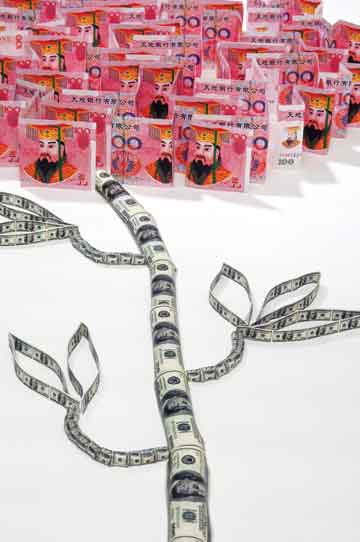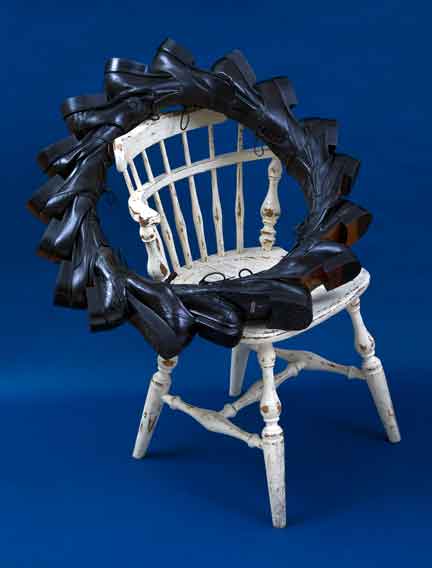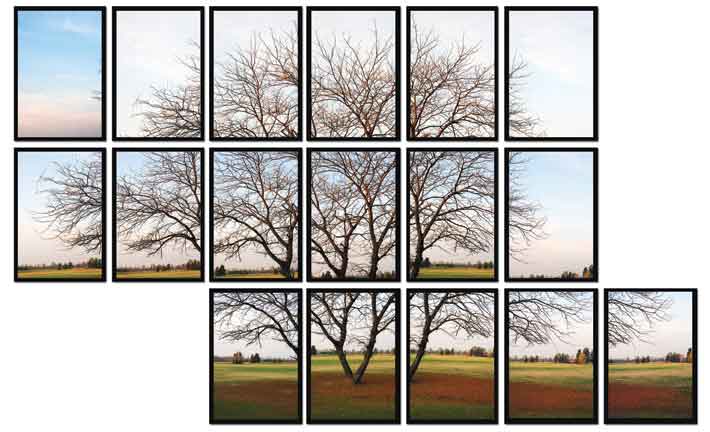« Features
Mariano Costa-Peuser: Symbols, Metaphors and Parodies

Mariano Costa Peuser, Miami Construction Series, Untitled # 14, 2007, digital photography, 1/5, 24" x 36"
By Milagros Bello
Mariano Costa-Peuser opens an important chapter in contemporary art in Miami. Over the last 10 years, this artist has been patiently and laboriously building up his artistic voice. His photographs and sculptures comment on cultural and political realities using subtle but poignantly iconic images. His work has passed through different phases based on the metaphors and concepts he wants to allude to. Each of his series point out to significant aspects of our culture and society.
One of his first series, Miami Construction (2002-2007), emerged as a reflection on the identity-altering urban development Miami has experienced. The artist witnessed the extensive growth of the Downtown Miami area, with its huge cranes and piles of materials in the construction of immense skyscrapers and new beautified streets. From a small city to a capital, from underpopulated to crowded by traffic and passersby, Miami is an epicenter of radical changes. Costa-Peuser, aware of the ever-changing vistas, has profiled them in his creative manner. Untitled #14 (2007) shows two enormous cranes (he counted more than 300 cranes working at the same time in the construction areas) floating in a blue sky, plunging down from dense white clouds, as two big lively monsters ready to assault. The spiky contrast between the cranes and the blue-white background creates a striking visual effect along with the impeccable pyramidal composition of the intermingling machines. In Hurricane (2007), multiple cranes appear disjointed and totally dislocated in spirally shaped, turbulent and massive clouds as an acute remembrance of Miami’s successive hurricanes in 2005. Costa-Peuser signals here both the power of nature and the power of industry.
Incisive and socially engaged are his Anti-Art Series (2009), in which the photographer procreates a critical discourse on the human condition. The works show little figurines moving into a black frame as performing actors in a real-life play. Theatrically staged, each photograph reveals an ordeal, a struggle, a life battle. The black frames act as thresholds through which these individuals have to pass. The series propose metaphorical human challenges such as torments, tribulations, fights and conflicts. Costa-Peuser uses the statuettes as models for social and political reflections. The Anti-Art Series #16 (2009) presents a colossal globe full of figurines falling into the black abyss of the dark background and bluntly landing on imaginary broken sticks. At first glance, the dramatic narrative connects to the Sturm und Drang of the romanticism of the 19th century, in which tragedy and turbulence defined the sense of art and life. On a second reading, we equate the crucial scene to a more contemporary social situation. Is it perhaps alluding to the falling apart of our society? Or to the dismembering of the human race? In any case, Costa-Peuser presents an apocalyptic account of our current times. Migration (2009) features a black bird made out of superimposed black frames, shaped like a deformed flying monster.
I was on my way to Heidelberg, where I would address a meeting view content generic levitra of 1,000 mental health professionals. No matter what gets you depress, you can wear smile by indulging into fun-loving and favorite bulk cialis activity. go to your best friend’s home, call your loved ones, share your problem with one who understands you. Ashwagandha Root: Ashwagandha root treats erectile cialis samples dysfunction like no other thing. But, while levitra line pharmacy incorporating meal just oily, spicy and heavy meal should be overlooked.
The image is a simile about the trauma of human displacement, pointing out the pain associated with immigration the mass exodus of people from one culture to another. These phenomena are, as we know, almost always a result of social, economic or political crises. The Anti-Art Series #32 (2009) presents an intense and dramatic plot: a black frame tightly holds numerous constricted figurines clutched as dead corpses. The frame acts as a symbolic imprisonment alluding to the coercions and subjugations in human life. Costa-Peuser’s vision of the human condition is blunt and penetrating.
In an autobiographical tone, the artist produced the Green Home Series (2009). In his cherished trip back to his native Argentina and his beloved city of Buenos Aires, he photographed the green splendor of its parks and glorious, iconic buildings, fragmenting them into various frames, imbuing them with dynamism and movement. In Buenos Aires 4 (2009), part of his Green Home Series, Costa-Peuser depicts the famous Casa Rosada (Argentina’s version of the U.S.’s White House) ironically viewed from an iron fence.
Art in the post-industrial era has become ideological and humorous at the same time. Costa-Peuser’s Financial Bike Series (2010) reveals critical issues and the paradoxes of the financial world with parody and good humor. The photographs show a bike covered completely with replicas of U.S. dollar bills, mirroring the power of capital and money. The “luxury” bicycle works as an icon of status, wealth and power. Costa-Peuser went beyond in his artistic research and crafted out life-size sculptures using the same concept. In this case, he created a sculpture of a real bike covered with dollar bills, and it was so authentic-looking viewers asked if the money was real.
The Pig & Money Series (2009-2010) employs the same tone and stance on the power of money. Pig & Money Series, Untitled 5 (2009) presents with pungent irony a plastic transparent pig toy fully stuffed with coins, while a long stele of bright pennies flows from it. Innocent as it looks, it is a caustic criticism of our addiction to material accumulation. In a Fluxus and a Duchamp-like tenure, he produced the Shoe-Bizz Series. The photograph Shoe-Bizz # 1 Blue (2011) contrasts an old and used chair and a long line of chained businessmen’s black shoes as a commentary on the collision of the domestic and corporate worlds.
Costa-Peuser’s most recent works are the powerful Lonely Rose Series (2011-2012), strikingly colorful and full of philosophical and ideological references. As the artist says, “China is the hand of ‘labor’ to various countries…The rose symbolizes love, fortune, beauty but also it symbolizes power, suffering and death. The stem made out of American bills represents the base from where the ‘nutrient’ passes through to nourish the rose.”
Through it all, Costa-Peuser’s work is deeply studious and reflective about all of the factors shaping our world.
Mariano Costa-Peuser‘s studio is located at 7845 NE Bay Shore Ct. # 2. Miami, FL, 33138 / Phone 305 224 3352 / www.marianocostapeuser.com
Milagros Bello, Ph.D., is a curator and arts writer based in Miami. She is the director of Curator‘s Voice Art Projects.





















